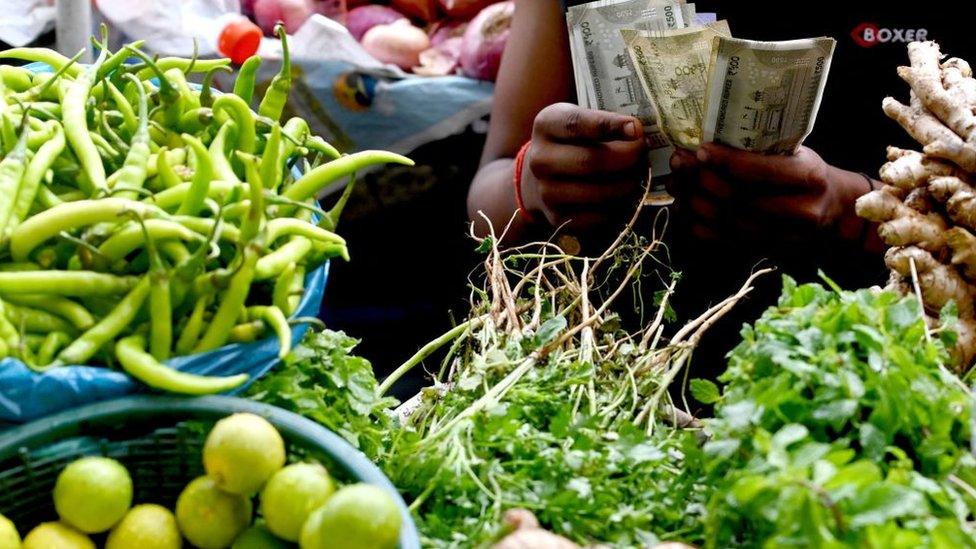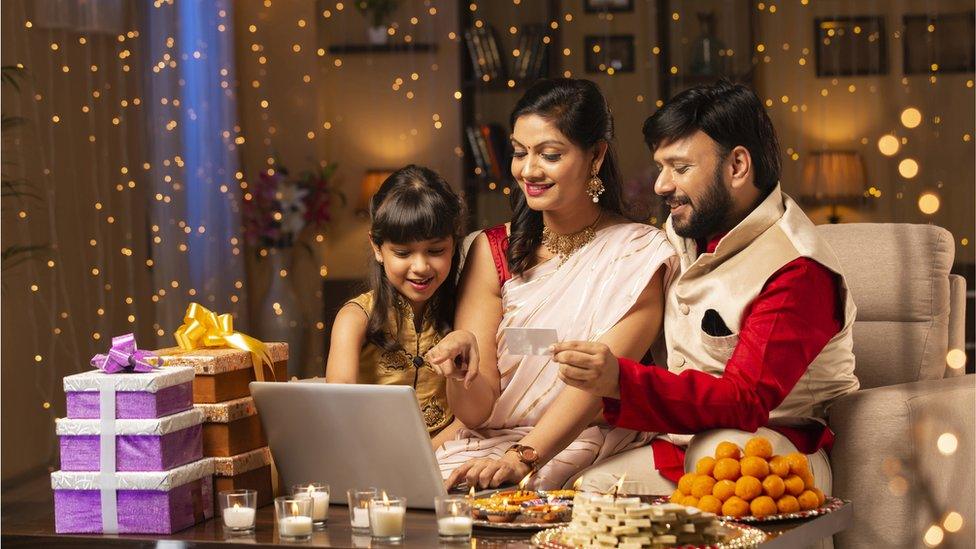India's middle class hit by rising cost of living
- Published

The rapid rise in the price of food and fuel in India is hitting household budgets
"We are really surviving on a day to day basis. Salaries are the same but expenses [are] at least double."
A steep rise in the price of essentials was already a drain for Santa, but when her landlord raised monthly rents by nearly two-thirds in June, it was a direct hit.
Santa, a 32-year-old social worker and teacher, and her husband live in the tech city of Bengaluru. They both provide for their respective families, while managing their own expenses.
Santa is the sole provider for five members of her family and has two jobs in order to earn extra money.
Their landlord raised the rent from 7,000 rupees ($86; £70) to Rs11,500 all in one go to compensate for not having put it up during the pandemic, but Santa says this is just bad timing.
Prices of perishables and food have almost doubled in the past year. The rapid rate at which prices have risen, especially for food and fuel, is eating into the households' budgets. Even though retail inflation eased to a three-month low in October, that's brought little relief.

Consumer goods sales hit a record high during Diwali, but cheaper products didn't sell as well
Now the family, whose monthly income is Rs20,000, has had to rework its expenses. This means cutting down on all frills and even some essentials.
"My parents love their tea, but for the last one year they must not have had milk tea. I buy dry groceries in limited quantities, only as much as we need, but daily expenses on fresh milk, vegetables, meat has been unmanageable."
As a social worker Santa's job requires her to travel across the city, but bus fares have risen significantly. "A daily bus pass which used to cost Rs30 earlier, now costs nearly Rs90."
The pandemic had already drained resources for Santa's family leaving them with limited disposable income. "I have no savings left. I have even pawned my gold jewellery last year when my father was hospitalised."
Covid, followed by the Russia-Ukraine war and the supply chain disruptions made everything expensive. Burdened by this dual blow there has been a perceptible change in consumption patterns in India - particularly among middle and lower income families.
The dichotomy in India's economic recovery is apparent.

Internet sales were strong during the festival season in September and October
A look at the buoyant stock markets and big companies' strong quarterly profit statements shows the shiny growth story. But a closer look reveals a widening economic disparity.
Most consumer goods companies have seen a drop in sales of entry-level or value products - from footwear to mobile phones to biscuits. Expensive brands, however, performed better than the mass market products.
Even during the festival season in September and October, when consumer goods sales were at a record high, it was the essentials and high-end products that did the best. Sales of entry-level products across all categories saw a near 10% decline compared with last year.
E-commerce in India saw a strong festive season in September and October with sales of nearly Rs755bn, according to a report by market intelligence firm RedSeer. But the finer print shows the average spend per customer has stayed subdued.
After two years of Covid lockdowns and quieter festivities, Indians geared up to celebrate the festival of lights in full fervour. Streets were lit up and people decorated their houses with electric lights and earthen lamps.
But it seems the celebrations in many households differed from previous years.
Consumers did indulge despite the rapid rise in prices, but not everyone joined in - and those who did were choosy.
The impact was more pronounced in rural and semi-urban India, home to more than half of the country's huge middle class.

Sarika's food bill has almost doubled in the past year
Sarika, a 47-year-old housewife, is one of them. She chose to recycle old dresses for the big annual festival of Diwali in October. While it is a tradition to buy new clothes for the festival, Sarika says the family has been making cuts in almost everything - from clothes to sweets and even basic foodstuffs.
Her monthly food bill has almost doubled in the past year. "From edible oils, to wheat, to cereals, vegetables - all have become costlier by 30-50%. Family expenses have almost doubled in last one year, we cannot afford to buy new clothes for everyone."
What's not rising is Sarika's family income. Her husband's watch shop is seeing fewer customers as they hold on to their old watches for longer or shift to online sales.
The family farm suffered crop losses due to unseasonal rainfall: "I had to prioritise daily needs and paying school and college fees my three children over other necessities," she says.
Sarika says the excitement surrounding the festival was already low as her son didn't travel from Pune, 150km (93 miles) from Mumbai, for Diwali. Why? Because the bus fares had almost doubled and he saved that money to pay his hostel bills that month.
"It hurts the most when you cannot even enjoy the small pleasures of life, just because you do not have enough money."
As the rising cost of living continues to bite and with no relief in sight, families are making hard decisions about their futures too.
Santa and her husband, married for three years now, were planning to buy a house in Bengaluru and start a family. But all plans have been shelved for now. "When we ourselves are struggling, how can we raise a child in this condition?"